Why pay big bucks for Valentine's dinner truffles when you can grow them yourself?
Everything your heart desires to know about the pricey, elusive underground mushrooms.
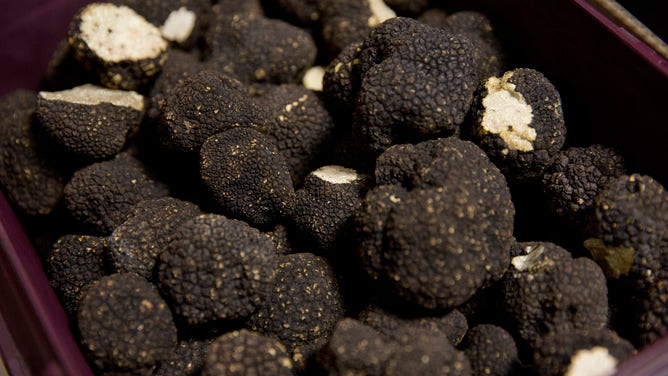
A bin of French black truffles for which diners will pay about $60 per ounce.
(Victor J. Blue/Bloomberg via Getty Images)
Truffles are the ultimate luxury splurge on special Valentine's Day menus, in part due to their price and because of the perception that they’re hard to find. But the truth is, the tubers are just about everywhere. They may even be growing in your own backyard.
"Once I had a truffle dog, I discovered there were truffles under a tree, just a few hundred feet from my house," said Charles Lefevre, owner of New World Truffieres and former president of the North American Truffling Society. He told the story of another truffle aficionado who lives in San Francisco. "His dog finds truffles under the street trees," Lefevre said.
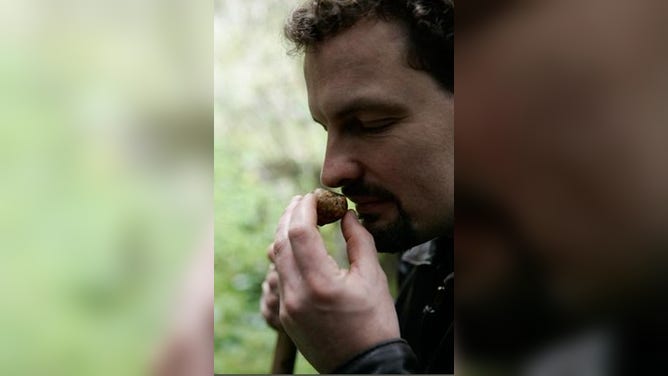
Charles Lefvre enjoying the scent of a freshly dug truffle.
Truffles are mushrooms that grow underground on the roots of trees. "The definition of a truffle is a mushroom that depends on animals to disperse it across the forest," explained Lefevre. "And generally speaking, they use strong aromas to attract the animals that disperse them."
Chefs pay a premium for the highly scented and flavored bulbs which they shave over dishes like pasta and risotto. Lefevre said restaurants price French black truffles at around $900 per pound, depending on size and quality.
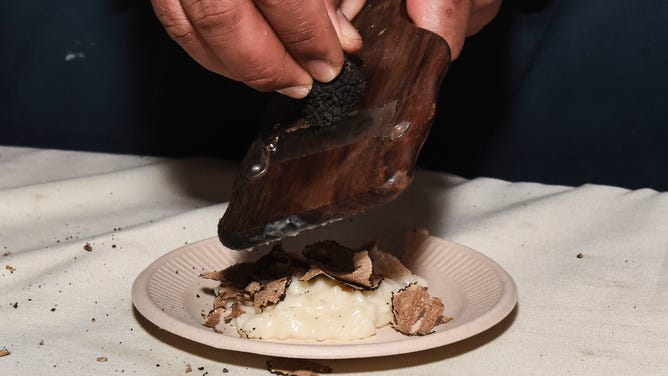
A chef shaves black truffle over an appetizer.
(Photo by Daniel Zuchnik/Getty Images for NYCWFF / FOX Weather)
Now is the prime harvest season for the French black Perigord truffles, Tuber magnum, in France and in Spain, Oregon, California, Texas, and Georgia.
"This was by far the most expensive white truffle season ever," said Lefevre, "With prices for top quality fresh white truffles going for $4500 a pound. And that's wholesale." The most expensive truffle ever weighed 2.86 pounds. A Hong Kong casino owner bought it at auction for $330,000 in 2010. The proceeds went to charity.

The world's largest white truffle, according to guniessworldrecords.com weighed 4.1 pounds. The most expensive truffle sold was only 70% of its size.
(TIMOTHY A. CLARY/AFP via Getty Images / Getty Images)
Italian white truffle season is winding down.
Are restaurant truffles not in your budget?
New World Truffiers sells trees inoculated with the high-priced fungus; French black Perigord, Italian white, white bianchetto and burgundy truffles.
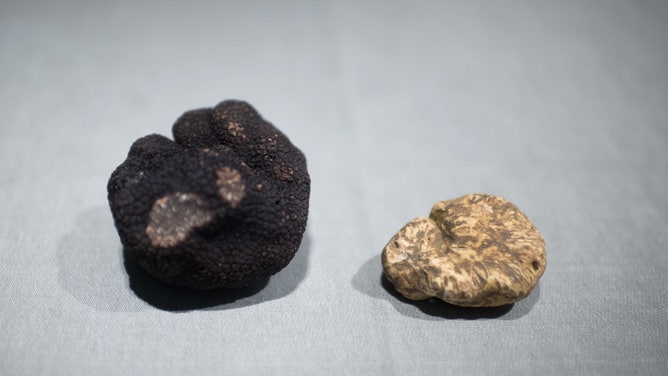
The French black Perigord truffle is on the left. The Italian white truffle in on the right.
(MARTIN BUREAU/AFP via Getty Images / FOX Weather)
Truffles live in a symbiotic relationship with trees like oaks and hazelnuts. Trees capture sunlight and convert it to sugar, some of which the tree passes to the truffle. The fungus mines minerals from the soil and shares them with the tree. "So it's an association that neither partner can live without," remarked Lefevre, who also earned a Ph.D. in Mycology, the study of fungus.
How do you find underground mushrooms?
Bring on the hounds. The Logotto Ramagnolo are bred to hunt truffles, but any dog can be trained. Lefevre trained his dogs and taught seminars about truffle hunting with dogs at the Oregon Truffle Festival, which he founded. Then after about four years, he found a pro.
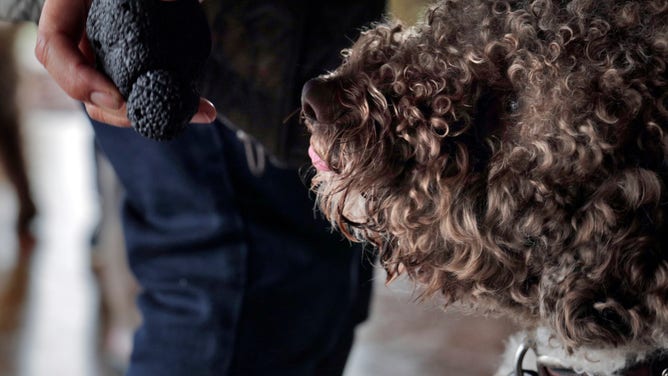
A Lagotto Romagnolo sniffing a truffle in training.
(Photo by Carlos Avila Gonzalez/San Francisco Chronicle via Getty Images / Getty Images)
"I found a search and rescue person who was tired of getting up at 3:00 in the morning and going to find dead people [with her trained dog]," he said. "She was excited about getting to be out in the woods looking for something that wasn't dead and in the daylight." She became the festival’s first official truffle dog trainer.
Native U.S. truffles gaining notoriety in culinary circles
Until the early 2000s, Oregon truffles were harvested with rakes, like potatoes. Not all the truffles were ripe and tasty. "Truffles are more like a fruit that has to be ripe to have its culinary value," said Lefevre.

He said after the introduction of truffle dogs to the Pacific Northwest, native Oregon truffle prices now rival those of the European truffles, "I would sell my beloved truffles wholesale price to distributors around the country for close to $400 a pound."
"And then those distributors are marking them up another 50%," Lefevre continued. "So I'd say that the wholesale price for the Oregon truffles is $600-800 per pound."
Pecan truffles fetch a high price and grow between Northern Mexico and the Great Lakes. One of the most extensive orchards is in South Georgia. Appalachian truffles thrive from the Smokey Mountains to the Great Lakes.
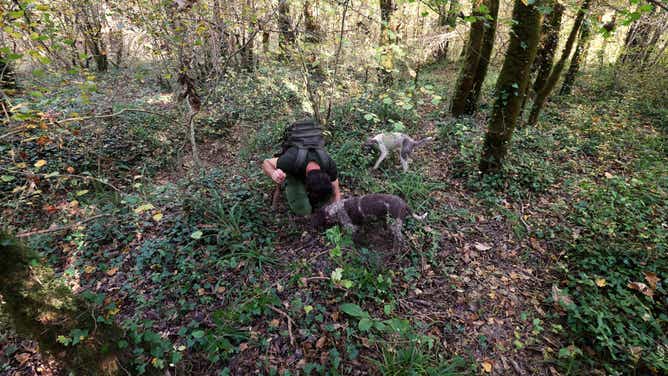
The truffle hunt.
(DAMIR SENCAR/AFP via Getty Images)
"They're actually more expensive than the famous French black truffles. However, I'm only aware of one commercial harvester in all of the United States," said Lefevre. "He has just recently received some publicity about this, but he's not willing to have his photograph published."
Big payouts keep farmers quiet about truffle sources
"Truffle hunting is a secretive business," said Lefevre of the lucrative hobby/career. That is one of the reasons the truffle hunting pig was passed over for dogs. "If you're walking a pig, everyone knows what you're doing. Walking a pig is a dead giveaway, and pigs have less stamina."
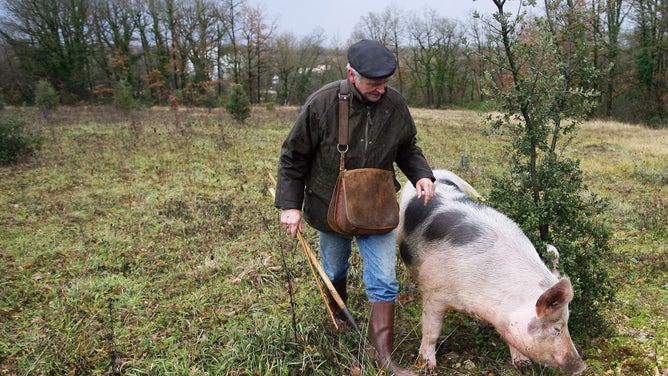
This truffle hunting pig in France's famed Perigord region, sniffed out the world's second most expensive truffle.
(Caroline Blumberg/Bloomberg via Getty Images / Getty Images)
He trained his dogs to find truffles and dig, "They just love it. What dog doesn’t love running outside, sniffing things and digging holes," said Lefevre. Not all dogs are trained to dig because that may damage the truffle.
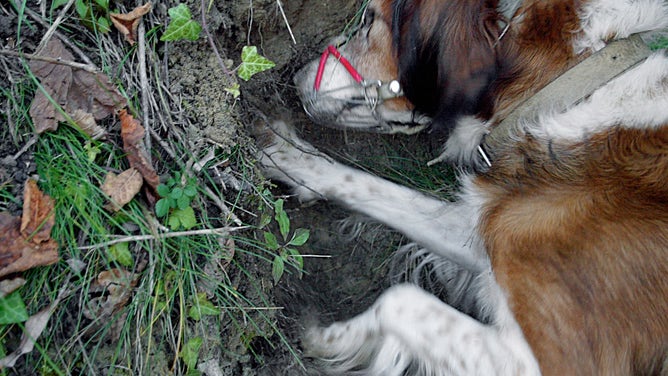
A truffle dog in Asti, Italy digs down to a ripe truffle. Notice the muzzle on the dog who enjoys hunting and eating truffles.
(Photo By STORMI GREENER/Star Tribune via Getty Images / FOX Weather)
"Actually, the good [human] truffle hunters will kind of bend down and sniff the ground," commented Lefevre. "You can smell the truffle yourself and tell whether or not it's really ripe."
Truffles can be just under the surface to three feet down he said, "On one occasion, it took both dogs, they were taking turns, digging the hole and continuing to dig deeper and deeper," said Lefevre about his dogs Dante and Mocha.
Weather, climate and truffles
Truffles thrive in weather and climate similar to their native areas in which they evolved. The European truffles thrive in Mediterranean climates, dry summer and wet winter and fall and mild all year long. The West Coast, which we think of as a Mediterranean climate, is drier than Southern Europe, so most truffle farmers have to irrigate.
Oregon, this year is having a tough time with truffle, said Lefevre, "Despite what appeared to be perfect weather, we're having a crop failure, and everyone's speculating that it's because of the extreme drought through the summer and the heatwave that we had in late June."
120 DEGREES FROM HISTORIC JUNE HEAT WAVE CONFIRMED AS WASHINGTON STATEWIDE HEAT RECORD
European truffles succeed along the West Coast from Washington to North Mexico. They also do well from Northern New Mexico to North Georgia, then up the coast and the Appalachian Mountains to the Virginia coast.
Pricey Perigords are ready now after a long wait
Perigord truffles form in the heat of the Summer and reach full size in September but need around six months in the ground to ripen.
Truffle orchards generally start producing truffles in three to six years, but Lefevre’s first client waited 12 years for his first mushroom.

Crews maintain this 10 acre orchard of hazelnut trees inoculated with truffle fungus.
(Michael Macor/The San Francisco Chronicle via Getty Images / Getty Images)
Some of Lefevre’s customers produce more than 100 pounds per acre per year; some don’t see any. He said the average is about 35 pounds per acre per year.
"Even in the very best truffle orchards, not every tree produces truffles," said Lefevre. "So, if you only have one tree or even just a few trees, there's this possibility of failure for no reason at all. Even if you've done everything right. I don't recommend planting small orchards."
If you plant them, they will come
"I have 31 customers who are growing truffles in their orchards, and maybe half of those people are selling their crops, so they're harvesting enough truffles that they can sell them," said Lefevre. " And nobody at this point is having to ship their truffles anywhere. They're finding very, very local demand, even in places parts of the country where before this you would never have found a French black truffle on the menu."
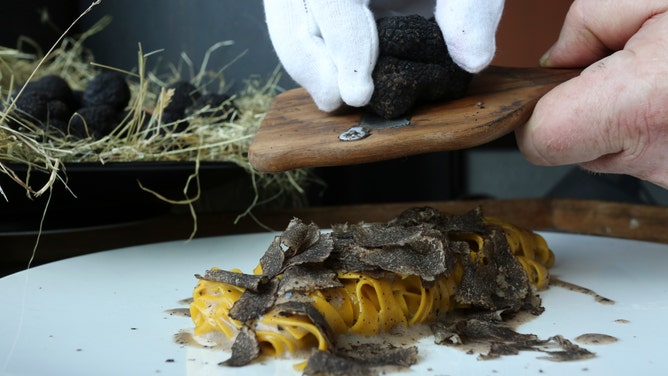
Homemade tagliatelle with parmigiano sauce and shaved Perigord black truffle.
(Jonathan Wong/South China Morning Post via Getty Images / Getty Images)
"If somebody shows up in the back that the back door of the restaurant with a basket of truffles, they almost can't say no," said Lefevre about the "rare" mushroom.
So if you do need to woo your Valentine’s date or are considering a new career think about the truffle. You just need a dog that loves sniffing to start.